For my embedded application on Atmel SAM4E16C i need to place an array with firmware information at the end of the .hex file. I'm using Atmel Studio 7 with GCC.
I've already done this for Atmega168PB but somehow it doesn't work for this project.
OUTPUT_FORMAT("elf32-littlearm", "elf32-littlearm", "elf32-littlearm")
OUTPUT_ARCH(arm)
SEARCH_DIR(.)
/* Memory Spaces Definitions */
MEMORY
{
rom (rx) : ORIGIN = 0x00420000, LENGTH = 0x000E0000 /* changed to leave space for 128KB Bootloader -> was ORIGIN = 0x00400000, LENGTH = 0x00100000 */
ram (rwx) : ORIGIN = 0x20000000, LENGTH = 0x00020000
}
/* The stack size used by the application. NOTE: you need to adjust according to your application. */
__stack_size__ = DEFINED(__stack_size__) ? __stack_size__ : 0x3000;
__ram_end__ = ORIGIN(ram) + LENGTH(ram) - 4;
/* Firmware Info - 8 Bytes long at the end of ROM */
__FWInfo_start__ = ORIGIN(rom) + LENGTH(rom) - 8;
SECTIONS
{
.text :
{
. = ALIGN(4);
_sfixed = .;
KEEP(*(.vectors .vectors.*))
*(.text .text.* .gnu.linkonce.t.*)
*(.glue_7t) *(.glue_7)
*(.rodata .rodata* .gnu.linkonce.r.*)
*(.ARM.extab* .gnu.linkonce.armextab.*)
/* Support C constructors, and C destructors in both user code
and the C library. This also provides support for C++ code. */
. = ALIGN(4);
KEEP(*(.init))
. = ALIGN(4);
__preinit_array_start = .;
KEEP (*(.preinit_array))
__preinit_array_end = .;
. = ALIGN(4);
__init_array_start = .;
KEEP (*(SORT(.init_array.*)))
KEEP (*(.init_array))
__init_array_end = .;
. = ALIGN(0x4);
KEEP (*crtbegin.o(.ctors))
KEEP (*(EXCLUDE_FILE (*crtend.o) .ctors))
KEEP (*(SORT(.ctors.*)))
KEEP (*crtend.o(.ctors))
. = ALIGN(4);
KEEP(*(.fini))
. = ALIGN(4);
__fini_array_start = .;
KEEP (*(.fini_array))
KEEP (*(SORT(.fini_array.*)))
__fini_array_end = .;
KEEP (*crtbegin.o(.dtors))
KEEP (*(EXCLUDE_FILE (*crtend.o) .dtors))
KEEP (*(SORT(.dtors.*)))
KEEP (*crtend.o(.dtors))
. = ALIGN(4);
_efixed = .; /* End of text section */
} > rom
/* .ARM.exidx is sorted, so has to go in its own output section. */
PROVIDE_HIDDEN (__exidx_start = .);
.ARM.exidx :
{
*(.ARM.exidx* .gnu.linkonce.armexidx.*)
} > rom
PROVIDE_HIDDEN (__exidx_end = .);
. = ALIGN(4);
_etext = .;
.relocate : AT (_etext)
{
. = ALIGN(4);
_srelocate = .;
*(.ramfunc .ramfunc.*);
*(.data .data.*);
. = ALIGN(4);
_erelocate = .;
} > ram
/* .bss section which is used for uninitialized data */
.bss (NOLOAD) :
{
. = ALIGN(4);
_sbss = . ;
_szero = .;
*(.bss .bss.*)
*(COMMON)
. = ALIGN(4);
_ebss = . ;
_ezero = .;
} > ram
/* stack section */
.stack (NOLOAD):
{
. = ALIGN(8);
_sstack = .;
. = . + __stack_size__;
. = ALIGN(8);
_estack = .;
} > ram
. = ALIGN(4);
_end = . ;
/* 8 Byte Firmware Info Section */
.FWInfo : AT (__FWInfo_start__)
{
*(.FWInfo)
} > rom
}
This is the linker script i'm using. I've added the __FWInfo_start__ and the .FWInfo section.
In my application i tried to define the firmware info block with attribute section .FWInfo but i'm unable to locate the data in my .hex file.
#define SIZE_OF_FWINFO 8
const uint8_t nFirmwareInfoBlock[SIZE_OF_FWINFO] __attribute__((section(".FWInfo"))) = {
0xff, // reserved for future
0xff, // reserved for future
DEVICE_TYPE, // DeviceType
BUILD_NR, // BuildNr of Firmware
VERSION_MINOR, // VersionMinor of Firmware
VERSION_MAJOR, // VersionMajor of Firmware
0xFF, // Checksum
0xFF // Checksum
};
I hope someone can help me why this isn't working. Thanks in advance.
EDIT: Here are the entries in the .map file:
.data 0x00000000 0x0 src/main.o
.FWInfo 0x00000000 0x8 src/main.o
.debug_macro 0x00000000 0x8b0 src/main.o
and..
*fill* 0x200133b0 0x3000
0x200163b0 . = ALIGN (0x8)
0x200163b0 _estack = .
0x200163b0 . = ALIGN (0x4)
0x200163b0 _end = .
.FWInfo
*(.FWInfo)
OUTPUT(Dali4Net.elf elf32-littlearm)
as far as i can read from the context in the second block there should be an address written after the .FWInfo or?

